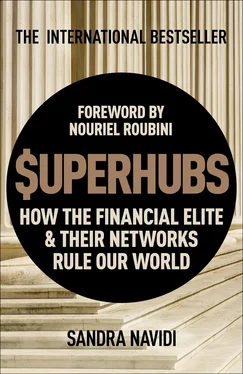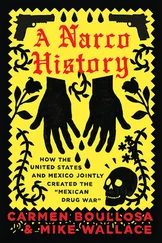Sandra Navidi - SuperHubs - How the Financial Elite and Their Networks Rule our World
Здесь есть возможность читать онлайн «Sandra Navidi - SuperHubs - How the Financial Elite and Their Networks Rule our World» весь текст электронной книги совершенно бесплатно (целиком полную версию без сокращений). В некоторых случаях можно слушать аудио, скачать через торрент в формате fb2 и присутствует краткое содержание. Год выпуска: 2017, Издательство: Hodder & Stoughton, Жанр: Старинная литература, на английском языке. Описание произведения, (предисловие) а так же отзывы посетителей доступны на портале библиотеки ЛибКат.
- Название:SuperHubs: How the Financial Elite and Their Networks Rule our World
- Автор:
- Издательство:Hodder & Stoughton
- Жанр:
- Год:2017
- ISBN:нет данных
- Рейтинг книги:4 / 5. Голосов: 1
-
Избранное:Добавить в избранное
- Отзывы:
-
Ваша оценка:
- 80
- 1
- 2
- 3
- 4
- 5
SuperHubs: How the Financial Elite and Their Networks Rule our World: краткое содержание, описание и аннотация
Предлагаем к чтению аннотацию, описание, краткое содержание или предисловие (зависит от того, что написал сам автор книги «SuperHubs: How the Financial Elite and Their Networks Rule our World»). Если вы не нашли необходимую информацию о книге — напишите в комментариях, мы постараемся отыскать её.
SuperHubs: How the Financial Elite and Their Networks Rule our World — читать онлайн бесплатно полную книгу (весь текст) целиком
Ниже представлен текст книги, разбитый по страницам. Система сохранения места последней прочитанной страницы, позволяет с удобством читать онлайн бесплатно книгу «SuperHubs: How the Financial Elite and Their Networks Rule our World», без необходимости каждый раз заново искать на чём Вы остановились. Поставьте закладку, и сможете в любой момент перейти на страницу, на которой закончили чтение.
Интервал:
Закладка:
Central bankers live in a rarefied and peculiar world. Due to the length of their terms and frequent meetings throughout the world, they know and trust one another and communicate on the same frequency. Highly educated and with a deep passion for economics, this small group of experts tends to be friendly, unpretentious, and approachable, though somewhat reserved, because they must be careful of what they say. Most of them are men, and many of them have known one another throughout their lives. Various central banks also hold international conferences, with Jackson Hole being one of the most well known. And, of course, many central bankers gather at the Annual Meeting of the WEF in Davos. In between all those meetings, they are in constant contact and consult with each other. The increased interconnectedness of our world and constant crises and emergencies have shaped a transnational central banker identity, further homogenizing an already fairly uniform group.
Federal Reserve Chairman: In Charge of the World’s Reserve Currency
The chairman of the central bank of the U.S., the Federal Reserve, is perhaps the most powerful person in the country besides the president. Unelected, independent, and accountable to Congress and the public, she or he has immense power with implications for both the U.S. and the world as a whole. Former Fed chief Ben Bernanke has been a superhub in the financial system as he steered the United States through the largest crisis since the Great Depression. His words moved markets, and his actions were of unprecedented consequence for all our lives. For years, he has been at the center of all key policy gatherings around the world.
I once visited him at the Fed with Nouriel Roubini. Upon entering the Eccles Building, I was struck by its austere classical elegance. Perhaps buildings somehow do take on and reflect the history that they witness throughout the years. Beyond housing the Fed, it also hosted the Arcadia Conference during World War II, at which Franklin Roosevelt and Winston Churchill coordinated their war efforts. The monumental white marble edifice is a modernist interpretation of the Beaux-Arts style, which reflects the spirit of the Depression, during which it was built. It comprises four stories designed in the shape of the letter H, with the empty spaces arranged as courtyards. Doric columns and grand dual staircases frame a two-story atrium, its floors and walls decked out in rich Georgia and travertine marble. A surreal, magic light emanates from the ceiling’s frozen skylight, which is decorated with a majestic eagle. The halls exude a dignified quiet and in the background a hint of classical music lingers.
The Fed chair’s high-ceilinged office is decorated with art from the Fed’s Fine Arts Program’s permanent collection, whose director described Bernanke’s taste as creative and innovative and his choices as unpredictable and unconventional. In person, Bernanke comes across as a genuinely nice and regular guy. He is always friendly, albeit slightly reserved, and markedly different from other financial top executives. He lacks the typical alpha male trait of a big ego, which might have interfered with his sober and prudent decision making.
Regrettably and somewhat unbelievably, the Fed completely missed the developing crisis buildup. Bernanke later conceded that he had failed to realize the scope of the credit bubble and that he did not understand “the interconnections to off-balance sheet vehicles and complex credit derivatives,”3 meaning the highly technical and nontransparent financial vehicles created for abstract and practically incomprehensible financial instruments. A sociological analysis has confirmed that the similar backgrounds of the top central bankers created an echo chamber and narrow mind-sets that failed to connect the dots.4 However, once Bernanke grasped the severity of the situation, he intervened forcefully and with great determination. Under his guidance, the Fed orchestrated the $700 billion Troubled Asset Relief Program (TARP) rescue package for the U.S. Treasury and instituted a lending program of virtually unlimited, unconditional financing to banks totaling $7.77 trillion in commitments. These programs were kept top secret even from lawmakers and top aides and only became public when Bloomberg LP prevailed in a lawsuit that requested disclosure of the emergency measures.5
The mild-mannered, soft-spoken, and unassuming Bernanke, who had overnight acquired almost unfathomable power, had suddenly taken a strong and courageous lead. Some of his measures may have lacked democratic legitimacy,6 but while in normal times democracy is effective, in times of an existential crisis, a more imperial style may sometimes be expedient. Bernanke warned that monetary policy was no panacea, but he was forced to step in to compensate for political inertia. Taxpayers may not have been adequately compensated for the risks taken with their money,7 but the system was saved, at least for the time being.
In terms of network dynamics, Bernanke is an outlier because he obtained his positions primarily based on academic credentials rather than through a network of well-established contacts. Although he was a star in academic circles, he did not have the airtight old boy’s network to propel him to the top, never having worked on Wall Street or participated in the Washington political establishment. He was an introvert, not known for being a suave networker, and who for the most part shunned the Washington cocktail circuit. Although Bernanke lacked the strong relationship portfolio possessed by his well-connected predecessor, Alan Greenspan, once he became Fed chief, he actively embarked on developing relationships with members of Congress and the White House, while also relying on the much better connected Hank Paulson and Fed board member Kevin Warsh.8
Bernanke’s background is anchored in the values of Main Street rather than Wall Street. He grew up in modest circumstances in a small town in South Carolina, where his parents owned a drugstore. During his university years, he worked typical student jobs in construction and hospitality. He excelled at academics, graduating from Harvard University and earning a PhD at the Massachusetts Institute of Technology (MIT). Stanley Fischer, who later became the governor of the Bank of Israel and thereafter Vice Chairman of the Federal Reserve, was his thesis adviser. While at Harvard, his path crossed with many who would later become key figures in the crisis: Lloyd Blankfein, CEO of Goldman Sachs; Kenneth Rogoff of Harvard University; and Paul Krugman, Nobel laureate and Princeton professor. Both Bernanke and Larry Summers earned degrees at MIT.
Bernanke went on to become a professor at Stanford Business School and a visiting professor at New York University before receiving tenure at Princeton University. His studies focused on the Great Depression, and his papers and speeches eerily foreshadow the crisis management job that awaited him years later in his career. As his academic footprint grew, he was recognized in Washington circles and became a member of the Board of Governors of the Federal Reserve. His background was all the more serendipitous in view of the fact that, at the time of his appointment as Fed chair, the administration had no idea of the financial system’s impending implosion.
Bernanke was well suited to steer the U.S. through the crisis not only because of his expertise but also because of his personality. Despite the chaotic environment, he proceeded in a methodical manner; when markets were panicking, he exuded calmness and successfully collaborated with the diverse parties involved. His unassuming demeanor was a refreshing antithesis to the Greenspan personality cult, and in contrast to his predecessor’s convoluted and opaque “Greenspanese,” Bernake explained complex issues in simple terms in an effort to promote transparency. Bernanke also possessed the diplomatic and political skill to deal with the supersized egos he had to bring to the table during this time.
Читать дальшеИнтервал:
Закладка:
Похожие книги на «SuperHubs: How the Financial Elite and Their Networks Rule our World»
Представляем Вашему вниманию похожие книги на «SuperHubs: How the Financial Elite and Their Networks Rule our World» списком для выбора. Мы отобрали схожую по названию и смыслу литературу в надежде предоставить читателям больше вариантов отыскать новые, интересные, ещё непрочитанные произведения.
Обсуждение, отзывы о книге «SuperHubs: How the Financial Elite and Their Networks Rule our World» и просто собственные мнения читателей. Оставьте ваши комментарии, напишите, что Вы думаете о произведении, его смысле или главных героях. Укажите что конкретно понравилось, а что нет, и почему Вы так считаете.












